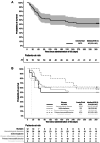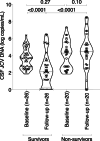Progressive Multifocal Leukoencephalopathy Treated by Immune Checkpoint Inhibitors
- PMID: 36151879
- PMCID: PMC10092874
- DOI: 10.1002/ana.26512
Progressive Multifocal Leukoencephalopathy Treated by Immune Checkpoint Inhibitors
Abstract
Objective: Our aim was to assess the real-world effectiveness of immune checkpoint inhibitors for treatment of patients with progressive multifocal leukoencephalopathy (PML).
Methods: We conducted a multicenter survey compiling retrospective data from 79 PML patients, including 38 published cases and 41 unpublished cases, who received immune checkpoint inhibitors as add-on to standard of care. One-year follow-up data were analyzed to determine clinical outcomes and safety profile. Logistic regression was used to identify variables associated with 1-year survival.
Results: Predisposing conditions included hematological malignancy (n = 38, 48.1%), primary immunodeficiency (n = 14, 17.7%), human immunodeficiency virus/acquired immunodeficiency syndrome (n = 12, 15.2%), inflammatory disease (n = 8, 10.1%), neoplasm (n = 5, 6.3%), and transplantation (n = 2, 2.5%). Pembrolizumab was most commonly used (n = 53, 67.1%). One-year survival was 51.9% (41/79). PML-immune reconstitution inflammatory syndrome (IRIS) was reported in 15 of 79 patients (19%). Pretreatment expression of programmed cell death-1 on circulating T cells did not differ between survivors and nonsurvivors. Development of contrast enhancement on follow-up magnetic resonance imaging at least once during follow-up (OR = 3.16, 95% confidence interval = 1.20-8.72, p = 0.02) was associated with 1-year survival. Cerebrospinal fluid JC polyomavirus DNA load decreased significantly by 1-month follow-up in survivors compared to nonsurvivors (p < 0.0001). Thirty-two adverse events occurred among 24 of 79 patients (30.4%), and led to treatment discontinuation in 7 of 24 patients (29.1%).
Interpretation: In this noncontrolled retrospective study of patients with PML who were treated with immune checkpoint inhibitors, mortality remains high. Development of inflammatory features or overt PML-IRIS was commonly observed. This study highlights that use of immune checkpoint inhibitors should be strictly personalized toward characteristics of the individual PML patient. ANN NEUROL 2023;93:257-270.
© 2022 The Authors. Annals of Neurology published by Wiley Periodicals LLC on behalf of American Neurological Association.
Conflict of interest statement
Nothing to report.
Figures


References
-
- Lajaunie R, Mainardi I, Gasnault J, et al. Outcome of progressive multifocal leukoencephalopathy treated by Interleukin‐7. Ann Neurol 2022;91:496–505. - PubMed
-
- Cortese I, Muranski P, Enose‐Akahata Y, et al. Pembrolizumab treatment for progressive multifocal leukoencephalopathy. N Engl J Med 2019;380:1597–1605. - PubMed
-
- Walter O, Treiner E, Bonneville F, et al. Treatment of progressive multifocal leukoencephalopathy with nivolumab. N Engl J Med 2019;380:1674–1676. - PubMed
Publication types
MeSH terms
Substances
LinkOut - more resources
Full Text Sources

